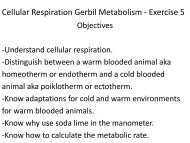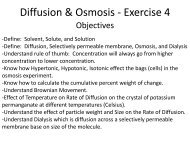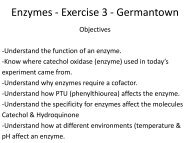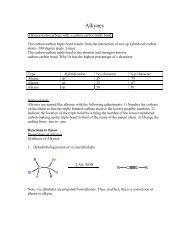Organic Molecules of Life - Exercise 2 - Science Learning Center
Organic Molecules of Life - Exercise 2 - Science Learning Center
Organic Molecules of Life - Exercise 2 - Science Learning Center
You also want an ePaper? Increase the reach of your titles
YUMPU automatically turns print PDFs into web optimized ePapers that Google loves.
<strong>Organic</strong> <strong>Molecules</strong> <strong>of</strong> <strong>Life</strong> - <strong>Exercise</strong> 2Objectives-Know the difference between a reducing sugar and anon-reducing sugar.-Distinguish Monosaccharides from Disaccharides andPolysaccharides-Understand the purpose <strong>of</strong> a control-Understand what gives you positive and negative reactionsfor the following assays and know what those assays aretesting for what specific type <strong>of</strong> sugar (mono, di, orPolysaccharides): Benedict, Barfoed, Iodine, Biuret,Miscibility, and Sudan Red. KNOW THE COLORS OF TUBESWHEN THERE POSTIVE AND NEGATIVE FROM THE ASSAYS…
There are four major molecules, also known asmacromolecules, and these include carbohydrates,proteins, lipids and nucleic acids. Each <strong>of</strong> these moleculescontain macromolecular varieties which can be chemicallydegraded by hydrolysis (broken down into smaller pieces).-Carbohydrates are polymers <strong>of</strong> monosaccharides(monomer).-Proteins are polymers <strong>of</strong> amino acids (monomer).-Nuclei are polymers <strong>of</strong> nucleic acids (monomer).-Lipids have the subcategories <strong>of</strong> neutral fats, and can bedigested into glycerol and fatty acids.
• Carbohydrates, proteins, and nucleic acids arepolymers (and they are made from smallermonomers).• Lipids are not polymers (they are not made frommonomers) You could say there are subunits inlipids, such as, Glycerol & fatty acids.Assay = Test
Carbohydrates – Complex Sugars• Monosaccharides – one sugar molecule• Disaccharides – two sugar molecules• Oligosaccharides – a few sugar molecules• Polysaccharides – many sugar molecules
What are Biological <strong>Molecules</strong>?• Carbohydrates Sugar Starch Cellulose• Fats Lipids Fatty acids Cell membranes• Proteins Amino acids Collagen Fibrin• Nucleic Acids DNA RNA
CarbohydratesMonosaccharide which is the basic unit <strong>of</strong> a carbohydrate, and can’t bebroken down anymore (smaller molecules) or it can also be called simplesugar. One significant group <strong>of</strong> Carbohydrates with 6 carbons is calledhexoses. The very common hexoses are glucose, galactose, and fructose.Each <strong>of</strong> the three sugars have the exact same molecular formula, which isC6H12O6, but there arranged differently, so these are called isomers. Thesesugars also exist in different forms one is a ring and the other is a chain.Monoasccharides in the chain form will have one carbon atom that isdoubled bonded to oxygen (C=O) which is known as a carbonyl group.Solutions <strong>of</strong> these sugars will contain both the chain and ringform in equilibrium, and each <strong>of</strong> the forms can freely convert into the alternative form under favorable chemical conditions.
Reducing SugarsWhen talking about chemistry the main things to focus on are electrons, those are thethings that make reactions happen. You will learn more about this in organic chemistry.An atom or molecules that receives one or more electrons form another substance issaid to have been reduced. The thing that donates an electron is known as thereducing agent.A reducing sugar is any sugar that possess a carbonyl group (C=O). Reducing sugarsare capable <strong>of</strong> donating an electron to another molecule. Reducing sugars can bemonosaccharides or disaccharides.The chain form <strong>of</strong> any monosaccharide has the chemical group (C=O). In some, but notall, disaccharides one <strong>of</strong> the two rings may be open, and they will have the C=O groupand thus be reducing sugars.Those that cannot open one <strong>of</strong> the rings will not be areducing sugars, because it won’t be able to donateits electrons.
All <strong>of</strong> these molecules are held by specific bonds, and thesebonds can be used to chemically identify the molecules thatposses them.The test that you performed tested for the chemicalreactions <strong>of</strong> these bonds (simple chemical test) which arealso known as assays, and these test could can be used toidentify the presence <strong>of</strong> a particular type <strong>of</strong> molecules in asimple mixture.Reducing agent: Substance that loses electrons (oxidizes).Oxidation agent: The electron lets the substance get oxidize.
CarbohydratesSolutions <strong>of</strong> these sugars will contain both the chain and ring form inequilibrium, and each <strong>of</strong> the forms can freely convert in to thealternative form under favorable chemical conditions.
MonosaccharidesDisaccharidesPolysaccharidesGlucoseGaltoseFructoseRiboseMonnoseSucroseMaltoseLactoseStarchCelluloseGlycogen
• What’s a control, what’s thepurpose <strong>of</strong> having it?
Control• When doing an assay (test) a control test must bedone. The control tube will contain everything thatthe assays contain except the substance to betested. In the assays, water is the solvent for all <strong>of</strong>the other substance and will be in the control, alongwith the test reagents.• The control test is the negative standard againstwhich the assays are compared.
Page 22 – Lab Book
Page 22 – Lab Book
Disaccharides: Lactose & MaltoseMonosaccharides: Glucose, Fructose, GalactosePolysaccharide: StarchSucrose Diasscahride: This always has rings, so it’s a non-reducing sugar.You could put sucrose into any solution, and it’s the same thing as throwingwater, so nothing would change.
Benedict’s Assay for Reducing SugarsThe Benedict reagent is a clear blue solution <strong>of</strong> Copperhydroxide (Cu (OH)2) at an alkaline pH (7). When this ismixed with a solution containing a reducing sugar andheater the Cu ion is reduced to cuprous form, which willmake the solution the solution would become turbid(cloudy).The color change in a positive assay can vary from greenishto bright red, depending open the strength <strong>of</strong> the reducingsugar (which determines how much precipitate will beformed). A positive Benedict’s assay indicates thepresence <strong>of</strong> a reducing sugar either mono ordisaccharides.
Benedict’s AssayMacromolecule Monomer Assay Name Assay Indicates Positive Result lookslike:CarbohydrateMonosaccharide(simple sugar)Benedict’s AssayPresence <strong>of</strong> areducing sugar(could be amonosaccharide ordisaccharide)A cloudy (turbid)color change fromblue to greenish orbight red color
Barfoed’s Assay for MonosaccharidesMonosaccharides can be distinguish from reducing disaccharidesby using Barfoed’s reagent, which is similar to Benedict’s, but setto an acidic pH (about 4.5). In an acidic environment thereducing disaccharides cannot reduce the cupric ion, but themonosaccharide can.All rings in disaccharide are closed; therefore, cant’ be reducingsugar.A positive Barfoed’s assay indicates the presence <strong>of</strong> amonosaccharides and only monosaccharides, and is reenergizeby the production <strong>of</strong> a slight turbidity and a slight color changefrom blue to red/violet or green. If you see particles in thebottom <strong>of</strong> the test tube, it’s a positive result.
Barfoed’s AssayMacromolecule Monomer Assay Name Assay Indicates Positive Resultlooks like:CarbohydrateMonosaccharide(simple sugar)Barfoed’s AssayPresence <strong>of</strong> amonosaccharideA slightly cloudy(turbid) color changefrom blue to green orred/violet (looks forredish particles atbottom <strong>of</strong> tube)
Summary <strong>of</strong> Benedcit’s & Barfoed’s AssayNote: Those that cannot open one <strong>of</strong> the rings is not a reducing sugar.• Benedcit’s assay: Used to test for monosaccharides and disaccharides.It has a pH <strong>of</strong> about 7, but when the solution gains (reduces) an electronfrom copper ion the solution becomes a reducing sugar (positive result).In the Benedcit’s assay five carbohydrates were reduced - three weremonosaccharides, and the other two were disaccharides.• Barfoed’s Assay was used for testing monosaccharides too.Monosaccharides can be distinguish from reducing disaccharides byusing this test. But Barfoed’s test had a pH <strong>of</strong> 4.5, which is a more acidicenvironment. A positive result indicates presence <strong>of</strong> monosaccharidesand only monosaccharides.• In an acidic environment, disaccharides can’t gain an electron from thecopper ion, but monosaccharides can gain an electron from copperion. Those that cannot open one <strong>of</strong> the rings will not be a reducingsugars, because it won’t be able to donate its electrons.
Starch: Iodine AssayStarch is a polysaccharide composed <strong>of</strong> hundreds <strong>of</strong> units <strong>of</strong>glucose covalently linked together. The structure <strong>of</strong> starch is asuch that the molecule is coiled. Iodine [I2KI] will interactspecifically with these coiled molecules to form a blue to blackcolored complex.Note: Iodine will not react with other carbohydrates, thusretaining its original color <strong>of</strong> yellow or amber. If it is still thecolor <strong>of</strong> yellow or amber but diluted somewhat, the assay isnegative, but if it is any other color, such as, brown to reddishbrown to blue to black, then its positive.A positive iodine assay indicates the presence <strong>of</strong> starch, so if thecolor turns dark blue, or black, this is a positive result.
The Iodine Assay - StarchMacromolecule Monomer Assay Name Assay Indicates Positive Resultlooks like:Carbohydrate Monosaccharide The Iodine Assay Presence <strong>of</strong>StarchA color changefrom yellow toreddish brown orbluish/black
Proteins (peptide bonds) - Biuret AssayProteins are composed <strong>of</strong> atoms or elements C,H,O, N, & S. Proteins arevery large polymers. The monomer unit <strong>of</strong> proteins is an amino Acid.Although each different protein has a unique sequence <strong>of</strong> amino acids,the covalent bonds between adjacent amino acids are essentially thesame.A covalent bond between two amino acids is called a peptide bond.The presence <strong>of</strong> peptide bones can be determine by using Biuret test.In a strongly alkaline environment (pH 8-14), copper sulfate reacts withthe peptide bones, causing the blue color <strong>of</strong> the reagent to change to aviolet color.A violet color indicates a positive Biuret assay and also indicates thepresence <strong>of</strong> peptide bonds and <strong>of</strong> course <strong>of</strong> proteins.
Polypeptides• Polypeptides– Are polymers <strong>of</strong> amino acids– A peptide bond is a covalent bond between 2amino acids.• A protein– Consists <strong>of</strong> one or more polypeptides
Page 24 – Lab Book
Page 24 – Lab Book
Biuret Assay- ProteinMacromolecule Monomer Assay Name Assay Indicates Positive Resultlooks like:Protein Amino acids Biuret Test Presence <strong>of</strong>peptide bondsColor changefrom blue toviolet
Lipid - MiscibilityAll lipids are insoluble in water. Families <strong>of</strong> lipids, including fats and oils,phosopholipids, steroids, and carotenoids. We will look at triglycerides in lab.Fats and oils are polymers. The subunit <strong>of</strong> fats/oils are glycerol and three fattyacids.Miscibility Assay: If a fat or oil mixes with water in the test tube, two distinctlayers <strong>of</strong> liquid will form because oil and water do not mix, this wouldindicate a negative result (two layers <strong>of</strong> liquid), but if two the substancesmix, then it’s a positive result. Basically what this means is that the substanceassayed does not mix with water (negative miscibility).“Friendship and money…oil and water.”-Michael Corleone (Godfather III)
Lipids: Fatty AcidsCharged polar end• Long hydrocarbon chains• Very hydrophobic• Oil and water don’t mix• Used for energy storage• Very high energy• Long-term storageLipid tail end
• What’s so important aboutlipids, what barrier do theycreate in a cell?• Hint it has multiple heads &tails.
Phospholipid bilayer - Membrane StructureFluid Mosaic Model: fluid membrane with various proteins embedded in or attachedto a double layer (bilayer) <strong>of</strong> phospholipids.HydrophilicheadWATERWATERHydrophobictail
Page 25 – Lab Book
Page 25 – Lab Book
Miscibility Assay - LipidMacromolecule Subunit Assay Name Assay Indicates Positive Resultlooks like:LipidGlycerol + fattyacidMiscibility AssayPresence <strong>of</strong> aninsoluble(hydrophobic)substanceHere we look for anegative result,namely no mixing. Ifan insoluble substanceis present, there willbe two visible layers.
Lipid - Sudan Red AssaySudan Red Assay: The Sudan stain will mixwith fats and oils and stain them but will notstain water and water soluble compounds.A positive Sudan red assay indicates thepresence <strong>of</strong> a lipid such as fat or oil and viceversa. So if the substance stains red, theassay is positive.
Page 25 – Lab Book
Page 25 – Lab Book
Sudan (Red) Assay - LipidMacromolecule Subunit Assay Name Assay Indicates Positive Resultlooks like:Lipid Glycerol + fatty acid Sudan (Red)AssayPresence <strong>of</strong> alipidLipids (butwater) will stain
Questions• 1. You are given two unlabeled containers and told that one<strong>of</strong> them contains a solution <strong>of</strong> pure glucose and the othercontains a solution <strong>of</strong> pure maltose, a disaccharide. How canyou identify the content <strong>of</strong> the bottle by performing chemicalassays?• 2. What is a monosaccharide? Why all monosaccharides andmost disaccharides are reducing sugars?• 3. In solution, chain and ring forms <strong>of</strong> glucose molecules existin equilibrium. Explain this statement?• 4. Both fructose and glucose are reducing sugars. Whenthese two simple sugars become chemically bonded, adisaccharide, sucrose, is formed. Why sucrose is not areducing disaccharide?
Questions• 1. You are given two unlabeled containers and told that one <strong>of</strong> them contains a solution <strong>of</strong>pure glucose and the other contains a solution <strong>of</strong> pure maltose, a disaccharide. How canyou identify the content <strong>of</strong> the bottle by performing chemical assays? You can perform theBendicts and Barfoed’s assay to see what reactions are positive. Maltose will only bepositive in the Bendcit’s assay due to the pH (7) environment. And, if you perform theBarfoed’s assay and get a negative result, then you know you got Benedict’s assay formaltose. For glucose you get a positive reaction for the Bendict’s assay and a negativeresult for Barfoed’s assay.• 2. What is a monosaccharide? Why all monosaccharides and most disaccharides arereducing sugars? A monosaccharide is a simple sugar that contain a carbonyl group. Theycan accept (gain) the Cu ion under acceptable pH levels, for instance, pH 7.• 3. In solution, chain and ring forms <strong>of</strong> glucose molecules exist in equilibrium. Explain thisstatement? Solutions <strong>of</strong> these sugars will contain both the chain and ring form inequilibrium, and each <strong>of</strong> the forms can freely convert in to the alternative form underfavorable chemical conditions.• 4. Both fructose and glucose are reducing sugars. When these two simple sugars becomechemically bonded, a disaccharide, sucrose, is formed. Why sucrose is not a reducingdisaccharide? Sucrose always has rings, so it’s a non-reducing sugar. You could putsucrose into any solution, and it’s the same thing as throwing water, so nothing wouldchange.
Questions• 5. Write three names <strong>of</strong> monosaccharides.• 6. Write two names <strong>of</strong> reducing disaccharides.• 7. What is the difference between reducingdisaccharide and non-reducing disaccharides?• 8. What are three names <strong>of</strong> polysaccharides.
Questions• 5. Write three names <strong>of</strong> monosaccharides.Glucose, Fructose, & Galactose• 6. Write two names <strong>of</strong> reducing disaccharides.Lactose & Maltose• 7. What is the difference between reducing disaccharide andnon-reducing disaccharides? The environment, in our case,the pH was the factor. Under alkaline conditions adisaccharide could gain an electron from the copper ion,but in an acidic environment (pH 4.5) the disaccharidecan’t accept the electron from the copper ion.• 8. What are three names <strong>of</strong> polysaccharides.Starch, Glycogen, & Cellulose
a. Sucroseb. Maltosec. Starchd. Glucosee. Egg albuminQuestions• 9. This substance gives a negative Benedict’s assay, a negative Barfoed’sassay, a positive iodine assay and a negative Biuret assay.• 10. This substance gives a positive Benedict’s assay, a positive Barfoed’sassay, a negative iodine assay, and a negative Biuret assay.• 11. This substance gives a positive Benedict’s assay, a negative Barfoed’sassay, a negative iodine assay, and a negative Biuret assay.• 12. This substance is positive in Biuret assay and negative in all otherassays.
a. Sucroseb. Maltosec. Starchd. Glucosee. Egg albuminQuestions• 9. This substance gives a negative Benedict’s assay, a negative Barfoed’sassay, a positive iodine assay and a negative Biuret assay. C - Starch• 10. This substance gives a positive Benedict’s assay, a positive Barfoed’sassay, a negative iodine assay, and a negative Biuret assay. D - Glucose• 11. This substance gives a positive Benedict’s assay, a negative Barfoed’sassay, a negative iodine assay, and a negative Biuret assay. B - Maltose• 12. This substance is positive in Biuret assay and negative in all otherassays. E - Egg albumin
Questionsa. Sucroseb. Maltosec. Starchd. Glucosee. Egg albumin• 13. All test (Bendict’s, Barfoed’s, iodine, and Biuret) on the substance camenegative.============================================================• 14. Benedict’s assay is for ______________ Positive reaction for Benedict’sassay produces _________ color.• 15. Barfoed’s assay distinguishes between _________ and_______________.• 16. A protein solution can be identified by performing the _________assay.
Questionsa. Sucroseb. Maltosec. Starchd. Glucosee. Egg albumin• 13. All test (Bendict’s, Barfoed’s, iodine, and Biuret) on the substance camenegative. A - Sucrose============================================================• 14. Benedict’s assay is for reducing sugars Positive reaction for Benedict’sassay produces red color.• 15. Barfoed’s assay distinguishes between monosaccharide and reducingsugar.• 16. A protein solution can be identified by performing the Biuret assay.



